
There are three types of Orders:
Note: The RecognizeRevenueDuringFulfillment system option, determines whether an order or an invoice will be created when a customer purchases a shippable product or wait-listed event.
Fulfillment Orders are accessed in the Inventory module by clicking on the Fulfillment Orders group item and then using one of the available means to locate the desired order.

|
|
Fulfillment Orders Group Item in Inventory Module
|
Installment Billing Orders can be accessed from the Installment Billing tab in the Accounting module.
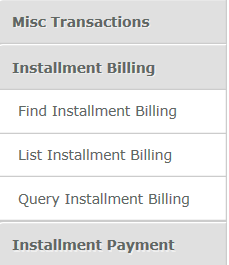
|
|
Installment Billing Group Item in Accounting Module
|
Note: The Generate Installment group item link gives the ability to create Installment Order invoices in bulk.
Installment Payment Orders can be accessed by clicking on the module items icon located in the upper-right of the Accounting module. After expanding the Accounting module items, click the Installment Payment option and then choose the method you wish to use to view Installment Payment Orders.
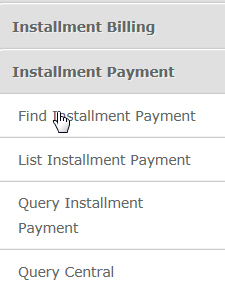
|
| Installment Payment Options in Accounting Module |
Most Orders are added through Centralized Order Entry.
To allow Installment Billing you must select the allow installments check box when adding a Membership Package and an Exhibit Show. You must then select installment as the Payment Type in the type drop-down list when placing your order through Centralized Order Entry.
When you place an order for a Fundraising Pledge through Centralized Order Entry, the Installment Payment Type is automatically added as a Payment Type to type drop-down list.
If the RecognizeRevenueDuringFulfillment system option is selected, the following scenario is true:
If the customer is paying for the purchase using a credit card, the credit card will be authorized for the full amount, but only charged for the invoiced amount. If another Payment Type is used, netFORUM will apply the payment to the amount being invoiced. If the payment amount is greater than the invoice amount, the system will create a credit for the overpayment with a credit type of orderpayment. That orderpayment is linked to that order. If you try to apply the credit to another invoice, you will receive a warning message that the credit is linked to another order.
There are multiple ways to locate a record using the Find page (for detailed methods on how to locate records, see the Find page). The Find functionality is universal throughout netFORUM. The results will display in a List page, which is also universal throughout netFORUM.
The Order_Installment information is stored in the database by the "columns" (fields) you selected when processing the order in Centralized Order Entry. Only a pre-defined set of columns pertaining to Order_Installment will be available to you on the Find - Invoice page.
The Find page is setup with a pre-defined set of columns (fields) versus a Query which allows you to select from ANY column in the search Table.
There are three profile pages relating to Order:
To go to an Order - Profile:
 to the left of the record you wish to view. The Order - Profile page displays.
to the left of the record you wish to view. The Order - Profile page displays.
In the example below, the search will be on all installments with a term of one year.

|
|
Find - Order_Installment_Billing page
|
The title of the Order Profile is identified by the Order Number and Type of order (Fulfillment or Installment).
Differing types of order profile pages share the same fields with the exception of the installment information and which icons display in the Actions Bar.

|
| Order Profile page |
The Order Profile includes:
The Actions Bar on the Order - Installment Profile includes the generate next installment![]() and adjust installment
and adjust installment![]() icons. On the Order - Fulfillment Profile, the invoice order icon, which is the identical image as the generate next installment icon, replaces these two icons and is used merely to generate the next invoice.
icons. On the Order - Fulfillment Profile, the invoice order icon, which is the identical image as the generate next installment icon, replaces these two icons and is used merely to generate the next invoice.
The Actions Bar on the Order - Installment - Payment profile includes the adjust installment![]() , void installment adjustment
, void installment adjustment![]() , and the Add Payment
, and the Add Payment![]() button .
button .
The Add Payment![]() button is now available on all order profile pages. (This option is available on orders that have not yet been fully paid.)
button is now available on all order profile pages. (This option is available on orders that have not yet been fully paid.)
The Edit - Order window for both profile pages gives you the ability to add or edit customer and payment information using the Add/Edit Drop-down feature  , as well as any notes you entered when the order was created. The windows are identical with one significant difference. The auto-pay installments check box displays on the Order - Installment Profile, which gives you the ability to add or change your customer's credit card number and/or Payment Method and arranges for the payment to made automatically. The invoice and order information will still display in the same child forms.
, as well as any notes you entered when the order was created. The windows are identical with one significant difference. The auto-pay installments check box displays on the Order - Installment Profile, which gives you the ability to add or change your customer's credit card number and/or Payment Method and arranges for the payment to made automatically. The invoice and order information will still display in the same child forms.
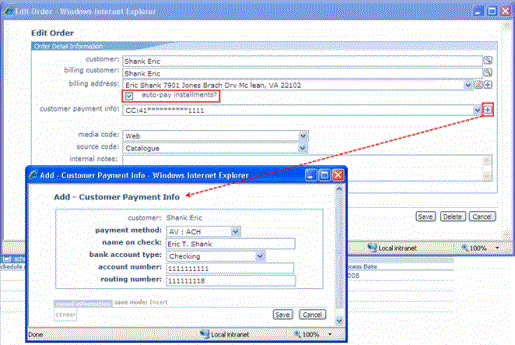
|
| COMPLETED Edit Order window with the Add - Customer Payment Info window |
When you void an installment invoice, you are voiding the invoice not the order. The voided invoice is marked for deletion and a new schedule is created. When the next installment is generated, there will be two invoices. The canceled one and the current one.
The procedures are the same as canceling any other invoice.
To void an order or installment schedule, click on the void order or void installment schedule icon that appears on the Order Profile Action Bar as seen below.

|
|
Use the void order or installment schedule icons on the action bar to void an entire order or the installment schedule if the order has not yet been invoiced.
|
Orders or installment billing can only be voided if invoices have not been generated. Meaning, the merchandise for the order has not been delivered, the event has not been attended, and so forth. Only open orders that have not yet been invoiced may be voided. In the case of a membership that has been set-up for installment billing, only those installments that have not been invoiced may be voided as seen in the example below.

|
| Sample installment billing for membership. Installment one has been invoiced leaving the remaining installments as open orders (and voidable). |
Note that the first installment in the schedule has been invoiced, leaving the remaining installments as open orders. This means that when you click the void installment schedule icon on the Actions Bar, only installments 2, 3, and 4 are able to be voided. (This also means that because one installment has been invoiced, the entire order itself is unable to be voided as well and the void order icon will be dimmed out).

|
| Installments 2, 3, and 4 are able to be voided since they are still open orders. |
Notice in the image above that, as noted, installments 2, 3, and 4 are still able to be voided in this membership because they are still open orders and have not yet been invoiced. When you select their checkboxes and click the Save button, the schedule childform on the Order/Installment Billing profile will also note that the final 3 installments (in this case) have been voided.

|
| Installments 2, 3, and 4 are voided on the schedule childform once saved |
In the sample above, the first installment for the order was invoiced immediately. This means that you would also have to void the generated invoice(s) first to then be able to void the order if the membership dates were activated immediately. If, however, you create an order without any installments generated and then void all open installment dates before the membership is activated, the membership will also cancel automatically for you since the entirety of the installment billing was canceled before invoicing as seen in the sample schedule child form seen below on the final example.

|
| All installments have been voided using proforma installment billing |
The individual who purchased this membership will have no active membership dates because it will be as if the schedule never existed. This is also true for event registrations. The registration record will be removed.
![]() This functionality is for generating the next installment and invoice for a specific order. The date of the next installment is typically, but does not have to be, done on the date of the next scheduled installment.
This functionality is for generating the next installment and invoice for a specific order. The date of the next installment is typically, but does not have to be, done on the date of the next scheduled installment.
To Generate the Next Installment:
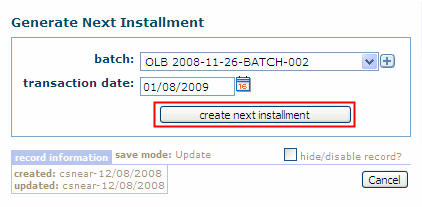
|
| COMPLETED Generate Next Installment window |
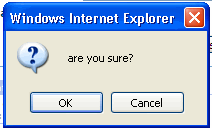
|
| Windows Internet Explorer warning window |
The date the next installment was generated will display in the schedule child form, in the Last Process Date column of next record on the schedule.

|
| The next record on the schedule in the schedule child form |
Click the Invoices tab to view the new invoice line item information. The invoice header follows the standard netFORUM convention of using the same number followed by a counter (56772-2), which will typically follow the schedule number.
_Tab_515x84.gif)
|
| Order Invoice information |
![]() The adjust installment icon on the Order - Installment Profile page gives you the ability to adjust the:
The adjust installment icon on the Order - Installment Profile page gives you the ability to adjust the:
Note: The latter two can be done manually, without adjusting the frequency and the number of installments, by highlighting the value in their respective fields and entering a new value. The amounts must equal the remaining balance or an error will be thrown. This functionality is also available for signed and pending signed pledges.
In the Adjust Installment window, the following will default to the current status of the installment:
The last bill date will default to the last installment that was invoiced, not the next generated if you created that installment prior to the scheduled date.
You are changing a customer's installments from four (4) to five (5) and changing the invoicing frequency from monthly to quarterly.
To Adjust the Installment:
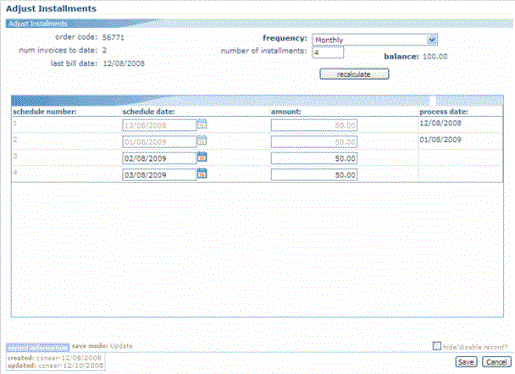
|
| The Adjust Installment window with current installment information |
Note: If you edit the number of installments, the new value represents the number of REMAINING installments, not the total number installments in that order.
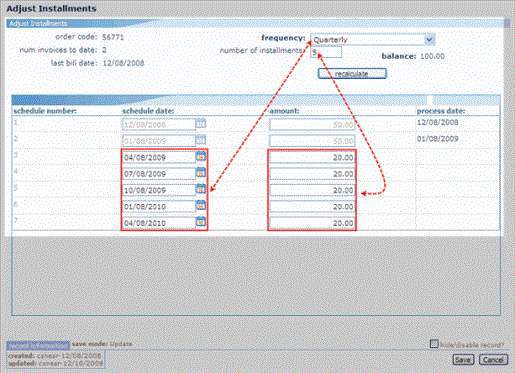
|
|
Adjusted values on the Adjust Installment window
|
The adjusted installment information displays in the summary child form on the Order - Installment Profile. Also, the frequency and # of installments fields will automatically flip to the new values in the Profile Information Panel.
This is typically used for large or multiple orders for a single customer where the invoicing will be done in installments. This is often referred to as "converting" an order to an invoice.
This functionality gives you the ability to invoice the full or a partial amount of the remaining quantity.
Note: The Order - Fulfillment Profile is available in the Inventory module.
To Convert an Order to an Invoice:
 ) a batch.
) a batch.

|
|
The Invoice Order window after an initial invoice has been created for a partial amount
|

|
| COMPLETED Invoice Order window for another partial invoice |
The invoice header follows the standard netFORUM convention of using the same number followed by a counter (56773-1), which will typically follow the schedule number. The information displays on the Invoice Profile and in the invoices child forms on the Individual and Organization Profiles as well as the Order - Fulfillment Profile.

|
|
invoices child form on the Order - Fulfillment Profile
|
This functionality gives you the ability to create multiple invoices for Installment Orders instead of individually.
This is typically used on your association's installment schedule, for example, quarterly, monthly, or annually, and is a useful tool for invoicing Memberships or Renewals.
In addition to the method mentioned below, you can also navigate to the Add - Installment Billing page from the left navigation panel or the List - Order _ Installment Billing page by clicking the Add Link .gif) in the List Page Action Links in the upper right corner of the page.
in the List Page Action Links in the upper right corner of the page.
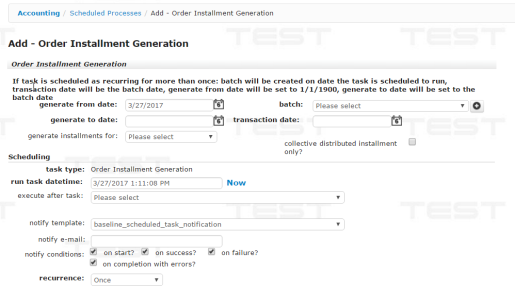
Generate Installments
Note: If the task is scheduled as recurring (reccurrence is more than Once), the batch is created on the date the task is scheduled to run, the transaction date is the batch date, the generate from date is 1/1/1900, and the generate to date is also the batch date. See step 8 below.
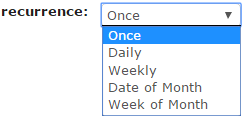
The recurrence has the following options:
From the Fulfillment Orders group item in the Inventory module, you can run a query of orders linked to a credit card that is about to expire. In the query, select a condition of Payment Info::Credit Card Expiration Date is less than YYYY/MM where YYYY/MM is a month or two in advance of the current year and month. Also choose Order::Type is either recurring for Recurring Gifts or installment or payment depending on the types of orders you want to check. Add any other filters you may need to ensure you select only active orders. This query will return any orders with a credit card about to expire.
The following reports also show this information:
Exceptions can be viewed from the Installment Billing Exceptions Profile Report.